




27 JULY - 26 AUGUST 2023
Curated by Gadigal Artist Konstantina
A new era of Cooee Art represents an exciting development for the gallery and for the wider art community in Australia. Although we will remain focused on First Nations art, the gallery, going forward as Art Leven, will exhibit nonIndigenous alongside First Nations artists, through specially curated individual projects. The projects offer an opportunity for new and innovative artistic expressions to emerge, and for meaningful conversations to take place beyond the closed commercial relationship between artist and gallery, furthering a transparent and comfortable understanding of the larger art market with the help of free-agent artists.
country x Country is the first iteration of the new annual program, launching as the inaugural exhibition in the new chapter of the gallery on July 27th 2023.

The specific focus of this project and the resulting exhibition was mark-making and craft of painting, especially relating to landscape painting and ways of seeing country. The workshop was based not around specific imagery, but around approach, how the tangible landscape is portrayed through the artists’ unique brushstrokes.
The workshop leading up to this exhibition was graciously hosted by the Warlpiri owners of Warnayaka Arts in Lajamanu over five days at the art centre studio. The project was not led or guided, open to anyone in the community who wanted to partake.

As early as the first day of painting in the centre, the joyful trio of Kitty Napanangka Simon, Annie Napanangka Simon and Biddy Napanangka Timms bestowed Tomkins with his Warlpiri skin name. For the rest of the workshop, the ladies addressed Neil only as Tjapanangka. After first setting up on the ground outside in the all-but-unused men’s painting area, Neil soon found his spot in the studio - crouched, as he often does in his Sydney studio space, on a paint-splattered mat, close by Kitty’s favoured painting table.
Within the buzz of Kitty’s return to painting, there were many peaceful moments, the soundscape consisting only of the ladies chatting and laughing in Warlpiri, often humming along to their songlines playing through speakers, and the ever active scratching of brush bristles on linen. In some moments between sessions, Kitty would turn and watch Tomkins work. She would smile and point to a section of his painting, recognising the depicted place in or around Lajamanu. She’d call out his name, Tjapanangka!, and confirm with him, teach him the Warlpiri term, or tell an anecdote about the spot. Each time, his smile beamed with pride at Napanangka Simon’s recognition of her Country in his work.
Alongside their distinctively bold and unapologetic use of colour, a major shared theme is the artists’ process of layering perception and memory, expressing their view of landscape as an act of recognition and blending.
The Country that Kitty paints is a description of the current landscape, yet simultaneously defined by stories of its creation (in her case, stories associated with the important Mina Mina Dreaming). Yet, what is really her Country was stolen and essentially destroyed by mining, so that Kitty and her Warlpiri people were forcefully displaced onto foreign Country now shared with its traditional owners, the Gurindji people. The same Dreamtime stories, inherited by Napanangka Simon far from their origin, have since become adapted, laying Warlipiri songlines onto twice-foreign soil.
This fracture is reflected in Napanangka Simon’s work - sometimes in the paths of dot-work that trail off and eventually disconnect, as though forgetting how a story ends. Other times, you may recognise it in her powerful instinctive use of negative space, a feature often on the forefront of Tomkins’ compositions as well.
In the crafting of his work, Tomkins uses memory in a similar way, folding it into the fabric of his works and creating a truer image of the artist’s perceived reality. A majority of Tomkins works in this exhibition spawn from photo composites, fractured and instinctively arranged before being sewn together by brushstroke.
From the finished paintings in this show, one can almost map the timeline of Neil Tomkins’ process. Only two works are entirely composed of a single view (Emu Rockhole and West Hooker Creek), both of which, aside from minor touches, were painted entirely en plein air at the scene. The final work (Bush Banana there) was completed largely after the return to Sydney. This richly colourful painting features three separate skylines, so spliced with memory that it reads almost as though seen through a kaleidoscope.

Contemporary landscape painter Neil Ernest Tomkins has developed a painting style recognisable for its blending and fragmenting of imagery and perspectives. Tomkins’ process usually begins en plein air, loosely drafted with a focus on composition and framework. Often, the artist refines his imagery by cutting up photographs taken while t ravelling, arranging them into collages that form a reference for his ensuing paintings. He is regularly exhibited and represented by galleries across Australia.
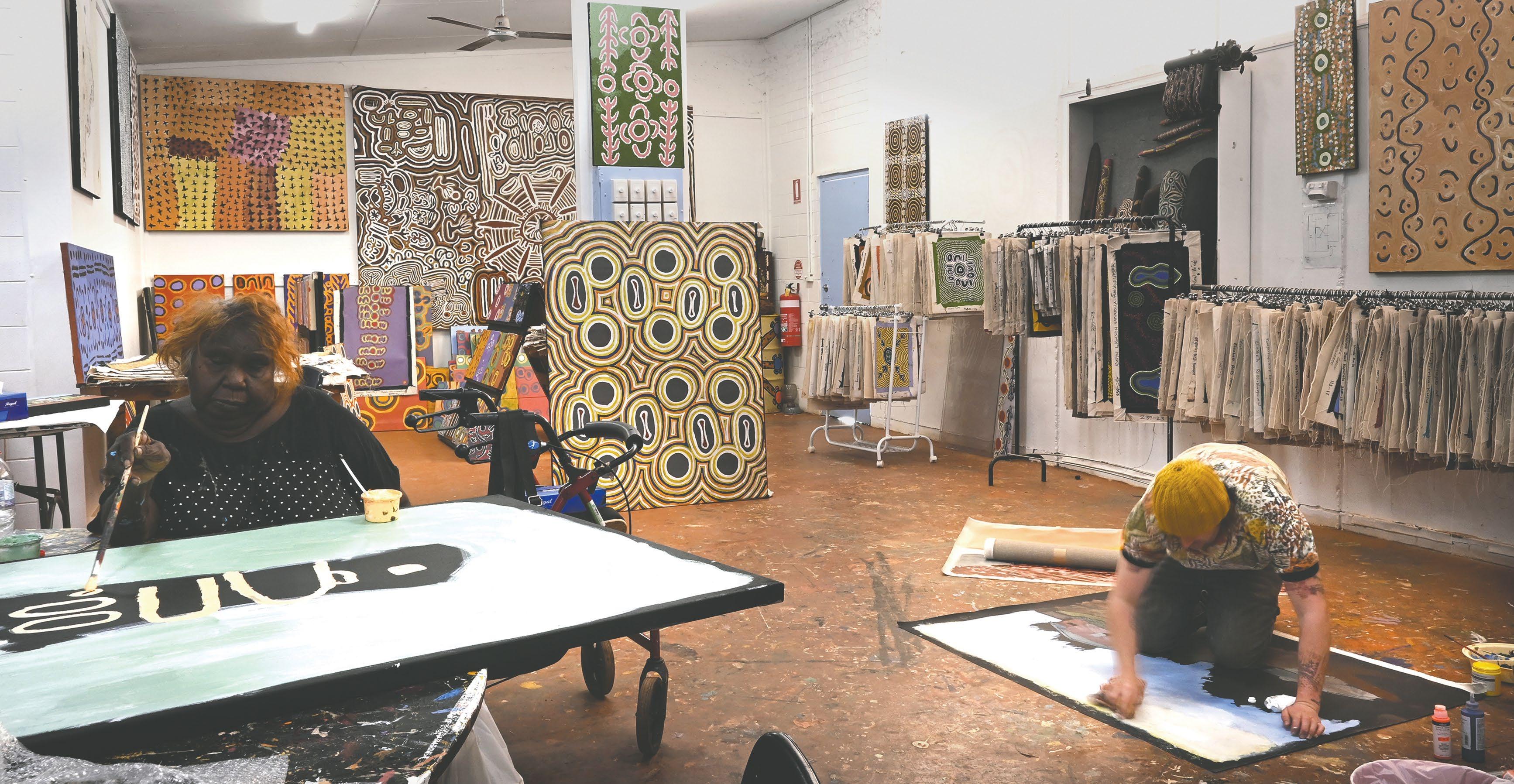



Central to all First Nations people in Australia is the innate sense of belonging to and being a part of PLACE. This sense of place is our attachment to Country and all that connects us to it, and it to us.
Country, or Ngura in Gadi or, is the lifeblood of our people. The heart, soul and creator of Culture. Ngura is the physical land, animals, water, sky and air. Ngura is the spiritual manifestation of our connection and engagement with, and to, Country. The emotional feeling one gets when standing on Country or working on Country for the betterment of our people and Culture. It is this Ngura that Aboriginal artists channel into their work, a physical storytelling from our rich oral history. It allows us to remember our place as our ancestors did and the opportunity to preserve these memories and histories for our next generations and for Millenia to come.
Viewed through this lens, our landscape arts practice, be it abstract or tangible, is an important document in time. Think of it as a contemporary geographical and psychographic mapping, from an individual’s perspective, using intuition, spirit and colour rather than topography and coordinates.
The challenge is to see beyond the term “Landscape”. Neil Tomkins, in his work, portrays his own view in a collage of memory and emotion, closer to mind-scape than landscape. Kitty Napanangka Simon doesn’t paint land, she paints Country capital C, she paints Ngura, she paints from our people’s history. For me as curator, it is important to understand the difference between the country and Country.
Later this year comes the final stage of this project, as I will be presenting my response to this launch exhibition alongside these two incredible artists. Until then, I’m excited to be standing with the viewer, enjoying the works as they sing to each other beyond any language barrier. So, welcome to my people’s Country, the Gadigal of the Eora Nation and welcome to country x Country.
The Western practise of landscape painting, seeing and re-communicating a physical place’s essence is a practice of intuition and feelingot merely of application and visual replication. One can be moved by a western landscape painting in a way not possible by visiting its actual location or seeing a photograph. This is the act of capturing Ngura, just in a different way. Capturing the moment in time. The emotion and spirit of that moment is what we see on the painted surface.





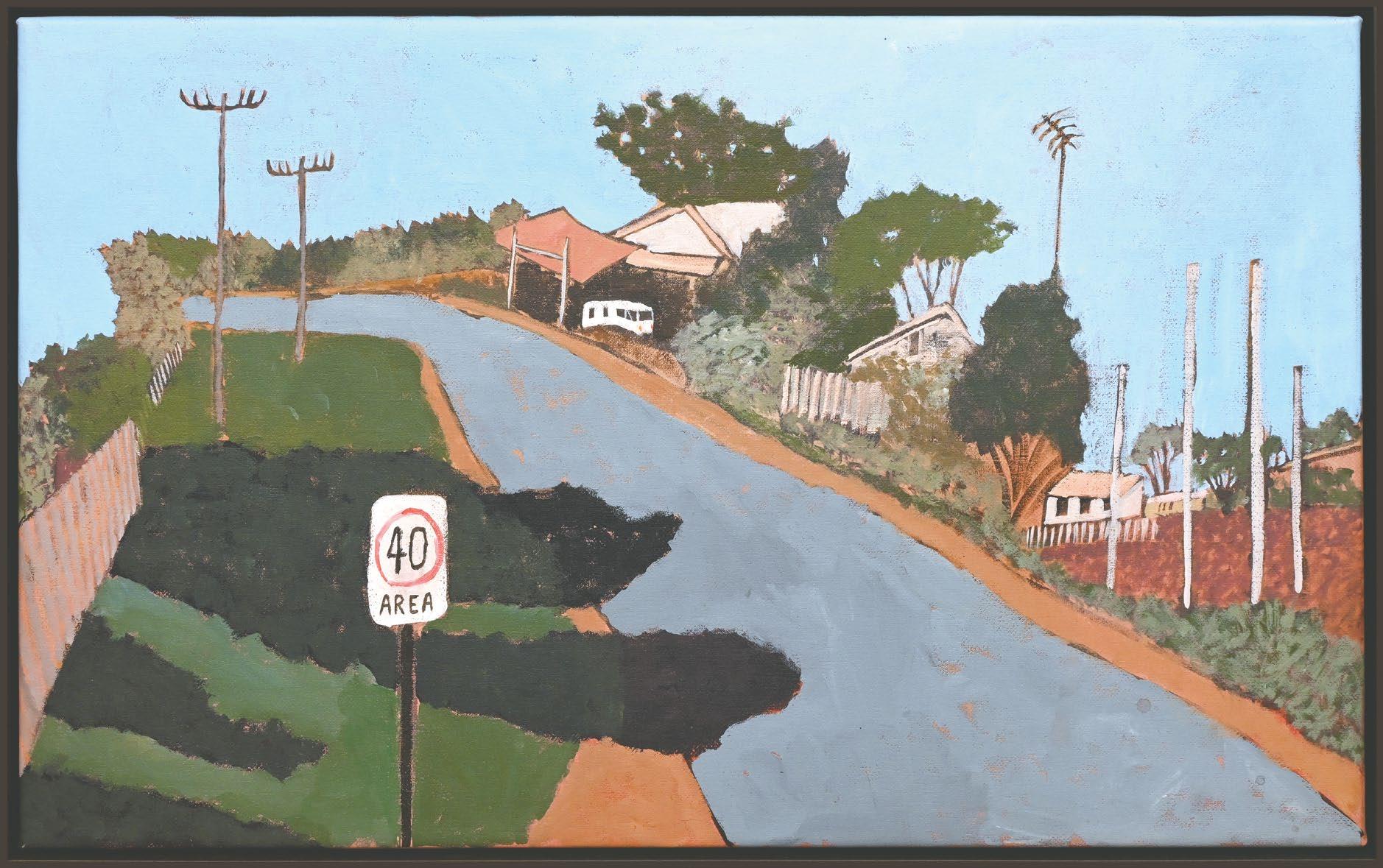
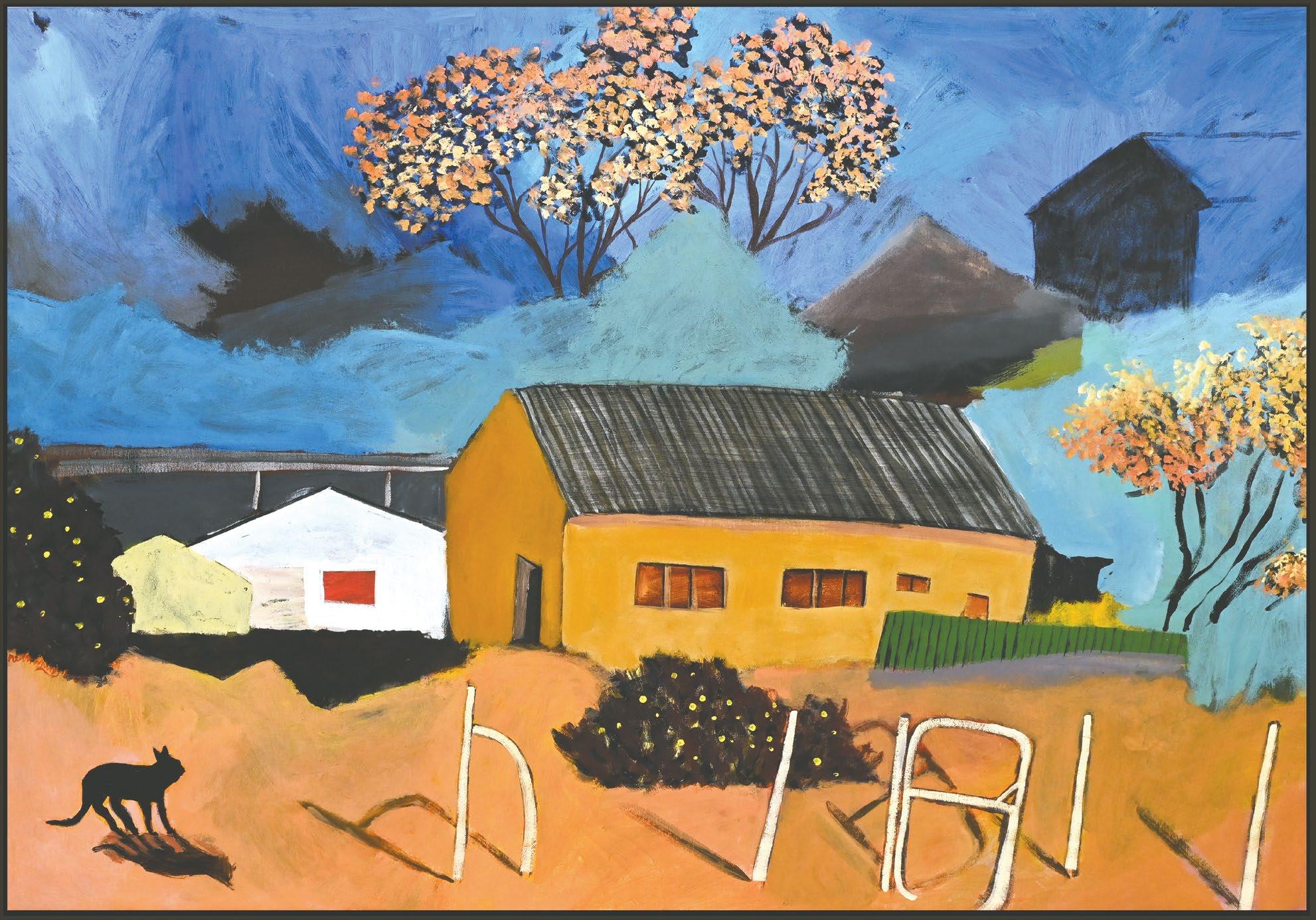




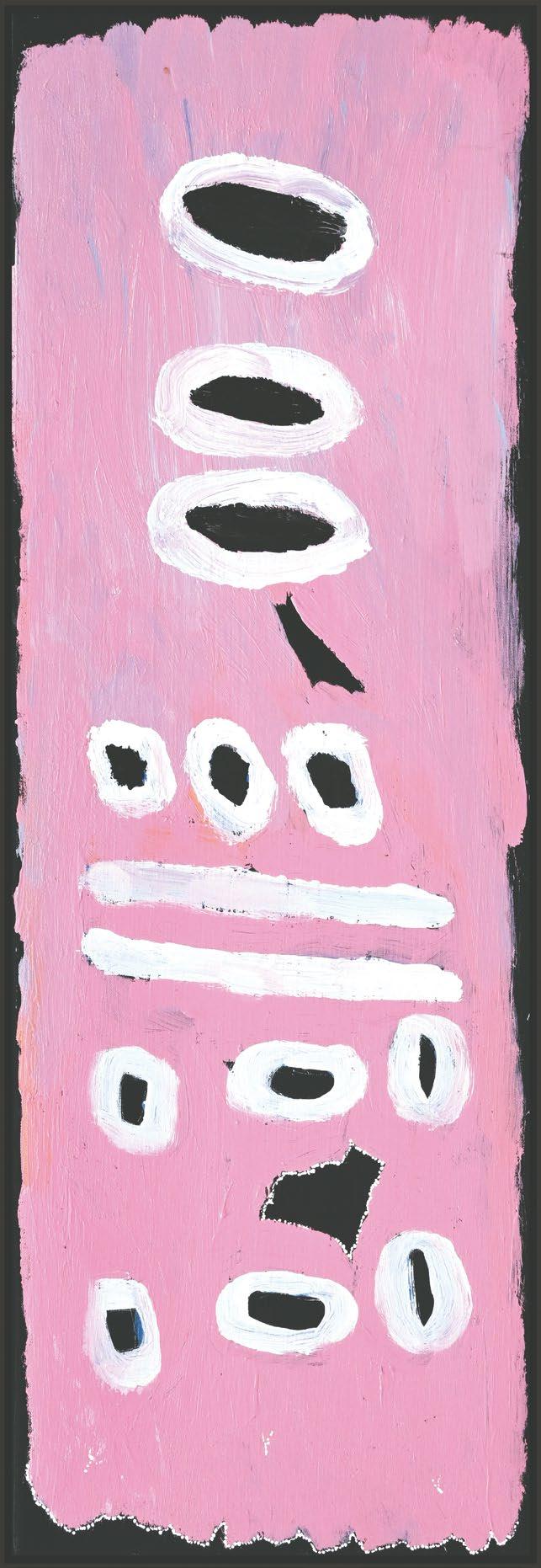
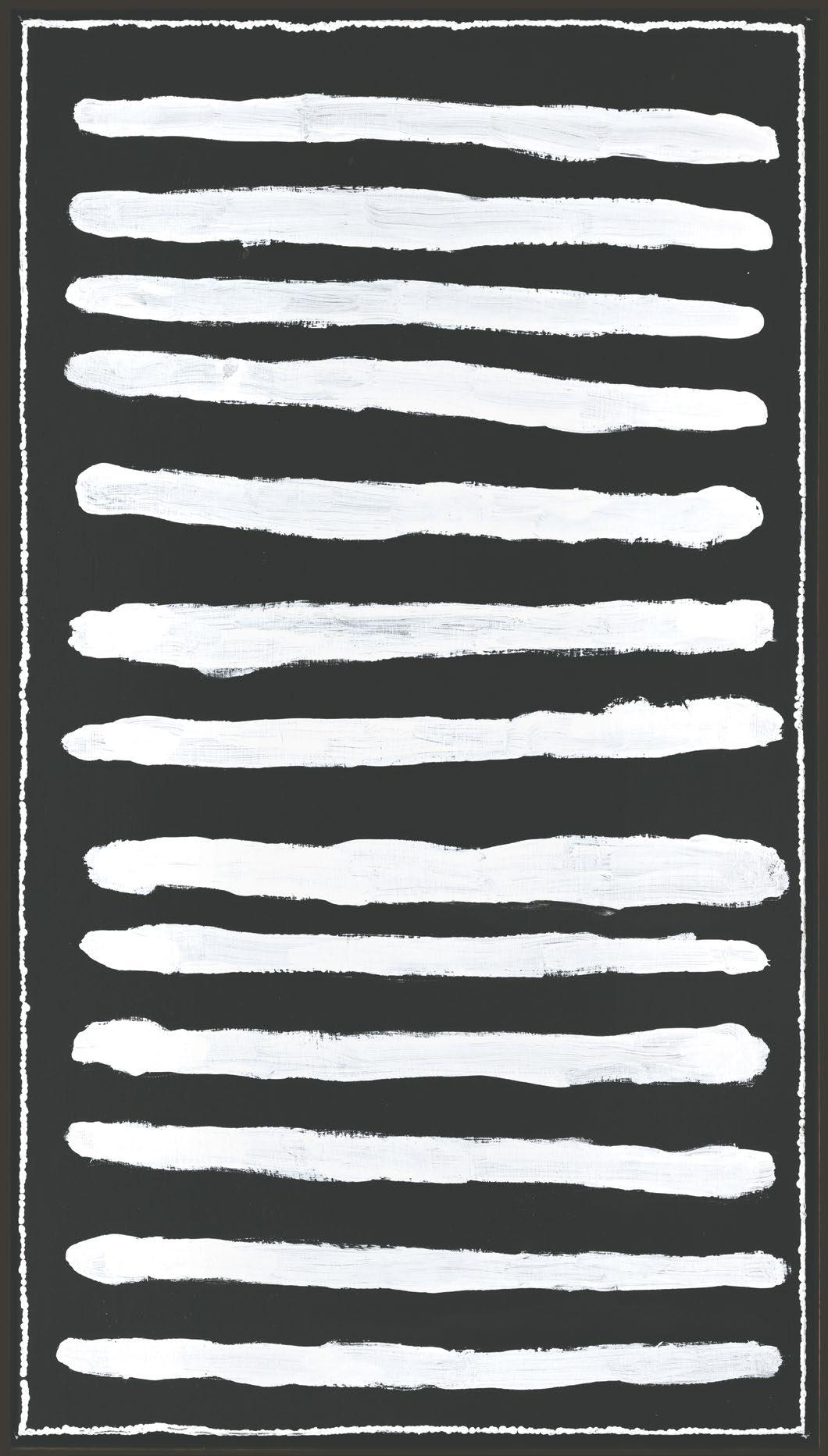








Bush Banana There is the final work to be completed for the exhibition. After several iterations and false starts, the densely layered painting finished far different from its first composition sketches. The painting features three separate skylines, so spliced with memory that it reads almost as though seen through a kaleidoscope. Removed from the workshop by almost a month, the painting in its mosaic of richly coloured fragments radiates a warmth in Tomkins’ recollection bordering on sentimental.
As fractured as the imagery is, the title of the work is drawn from a singular moment. Ricky Tjungurrayi Morrison, who worked at the art centre and with whom Tomkins quickly formed a friendship, had taken it upon himself to show Neil his home, speaking of each stretch of country through memories of his Grandfather, important elder Teddy

NEIL ERNEST TOMKINS
Bush Banana There | 2023 acrylic on linen | 90x120cm
Jupurrurla Morrison, as well as the stories and bush foods (wherever permitted and appropriate, depending on who came along) associated with each stretch of country. On our last day, Ricky guided us to Emu Rockhole, an important source of living water that we had been granted permission and encouragement to visit and record. (see page 16).
We had arrived during the tail end of a lush period following the rainy season, when large stretches of country surrounding the town were still bursting with soft yellow wattle flowers and rich green brush edging the ever-present rust-red desert sand. Only recently, the dirt roads had been flooded and where the rainwater had since evaporated the ground had turned to clay, divoted by the overlapping prints left by donkey hoofs, kangaroo paws, tyre threads and bare feet. With Mirri at the wheel of the art centre’s old Toyota Troopy, Ricky directed us with an uncanny awareness of the road. Without fail, he instructed which bumps in the road had to be sped through and which craters had to be slowly circumvented and where we had to quickly slam shut our windows to avoid getting whipped by encroaching branches, all the while pointing out landmarks and recounting old stories. On the return drive, the car rattling as we sped back over a bumpy stretch, Ricky pointed and yelled “Bush Banana!”, a bush fruit Tomkins had been eager to try.
The Troopy came to a stop and we stepped out onto the clay road. We stared blindly at the tree Ricky had pointed out, two rows in from the edge of the dirt road we’d been rattling along. The pale green fruit dangled lonely among leaves of the same colour. It was obscured by a spray of yellow pollen and to us it was entirely camouflaged. Though not to Ricky, who when we finally gave up picked it for us, and neither to Kitty who was putting the finishing touches on a painting of her Bush Onion when we got back to the art centre. The bush banana was stringy and dry when we tried it, past the point in its cycle when it can be enjoyed raw. As she painted, Kitty explained how you’d prepare it now, how to roast it in an open fire and unlock its sweetness.

Kitty Napanangka Simon is a dedicated artist with a distinctive, singular aesthetic. Her paintings – at first denounced by senior men for straying too far from the traditional idiom – have excited discriminating curators and collectors since her first solo exhibition at Cooee Art in 2013, winning admirers both inside and outside her tight knit Warlpiri community. The paintings appear to be grounded in abstraction, yet it would be hard to conceive of more descriptive visual articulations of ‘country’ in Australian Aboriginal desert art. Through the intersection of colour and free-form shapes and dots scattered in strings across the canvas, Simon describes in detail the desert flowers, salt encrustations and natural features of Mina Mina, the home of her sacred Dreaming in the south- western region of theTanami Desert.
She is is a keeper of women’s law. Most of her paintings depict Mina Mina, a sacred place for women’s business at Lake Mackay. As Kitty moves her brush across the canvas, she chants rhythmically her ancient song, part of her clan’s story still of profound contemporary relevance. Her vivid paintings are described as “Mina Mina Jukurrpa” or “Mina Mina Dreaming”, but Dreaming is in some ways an inadequate English translation of the word Jukurrpa.
Kitty painted her first works in the late 1980s before hanging up her paint brushes to focus on raising a family. She took up painting once more in 2008, by which time she had four grandchildren and five great-grandchildren. Experimenting with various styles, she eventually adopted a loose, immediate approach to painting and embraced a distinctly individual style.The works representing yawulyu (women’s ritual designs) employ optic whites and an array of pastels in large sweeps of tone-on-tone painting to capture the feeling and colour of desert flowers and the natural features of the surrounding salt plains at Mina Mina, 600 kilometres to the south of Lajamanu.
In 2020, Napanangka lost her sight due to cataracts and Gallery Director, Leven, through Cooee Art, paid for her surgery. After regaining her sight, Napanangka Simon’s painting practice has dwindled and this will be one of her first major forays back into painting with a renewed confidence in her exceptional talent.
Kitty likes to paint among other women, and they talk and laugh as they work. Beginning at the centre, she explains, the black represents an area burned by fire. The three white objects over the black are digging sticks, normally used by women to dig up yams. Blue on either side of the sticks is the lake. The pink strokes are female land, and white is salt.

SELECTED SOLO EXHIBTIONS:
2016 Making Memories, Cooee Art, Sydney, Australia
2015 Only Women Dance Till Dawn, New York, Cooee Art and Pollon Art
2013 Mina Mina, Cooee Art, Sydney, Australia
SELECTED GROUP EXHIBITIONS
2023 country x Country, Cooee Art Leven, NSW
Embrace Equity, Cooee Art, NSW
2022 Painting Words, Cooee Art, NSW
Women In Colour, Manning Regional Gallery, NSW
2021 Sydney Contemporary Art Fair, NSW
Cooee: Come Here, Cooee Art, NSW
2020 20|20 Artists from Over Australia, Cooee Art, NSW
Sydney Contemporary Art Fair, NSW
2019 Kitty Simon and the Ladies of Lajamanu, Cooee Art, NSW
Sydney Contemporary Art Fair, Carriageworks NSW
2015 June Tunbridge Gallery, Cottesloe, WA
2014 Masterpiece Art Fair, Chelsea, England
Contemporary landscape painter Neil Ernest Tompkins has developed a painting style recognisable for its blending and fragmenting of imagery and perspectives. He is renowned for his distinctive approach to mark-making and has been featured in myriad exhibitions across the globe, as well as being part of extensive commissions, murals, and residencies in Portugal, India, Peru, Mexico & Tasmania. Tomkins’ process usually begins en plein air, loosely drafted with a focus on composition and framework. Often, the artist refines his imagery by cutting up photographs taken while travelling, arranging them into collages that form a reference for his ensuing paintings. He is regularly exhibited and represented by galleries across Australia.
“My aim is to connect with place, to find the spaces of stillness within the motions of the everyday. In this sense I would approach direct references to landscape to be conceptual, abstract.
Often breaking down the subject matter into fragments, my work alludes to a connection through displacement.
With each body of work, I try to develop that idea of movement through the understanding of color. Travel contextualises my work, where the shifting light is more abstract, unrooted and adaptable.”
Neil Tomkins, 20232023 country x Country, Cooee Art Leven, NSW
2021 X-mas show, Maunsell Wickes Gallery, NSW
2020 Showcase, Michael Reid Gallery, NSW
2019 Open Call Salon, Delphain Gallery, UK
2018 Paper and Canvas, New Standard Gallery, NSW
2017 June, New Standard Gallery, NSW
2016 Higher Ground, Kinokuniya, NSW
2015 Art Parked, Artesian 4, NSW
2014 We, The Muse, Ambush gallery, NSW
2012 Outpost Festival, Cockatoo Island, NSW
2011 Communicating with Rocks, Mils Gallery, NSW
2009 Two Young Painters, Cat & Fiddle, NSW
2007 Ten Young Artists, Project Gallery, NSW
2018 Milton Post Office Residency, NSW Raizvanguarda Artist Residency Góis, PT Unconformity Festival Residency, TAS
2017 Q Bank Artists Residency Queenstown, TAS
2015 El Ray Private Residency Mazunte, MX
2022 Return of Rivers, Maunsell Wickes Gallery, NSW
2021 Between Dreams, Maunsell Wickes Gallery, NSW
2020 Now Here. Nowhere, Maunsell Wickes Gallery, NSW
2019 This Dream Called Reality, 17 Oxford St, NSW
Synergy Collaborations, Studio Gallery, VIC
2018 This Could be Your Color, Raizvanguarda, PT
The Veil, New Standard Gallery, NSW
2017 Rising Dark, New Standard Gallery, NSW
2016 A Deep Rumble, New Standard Gallery, NSW
2014 East of Eventuality, Ginkgo Gallery, NSW
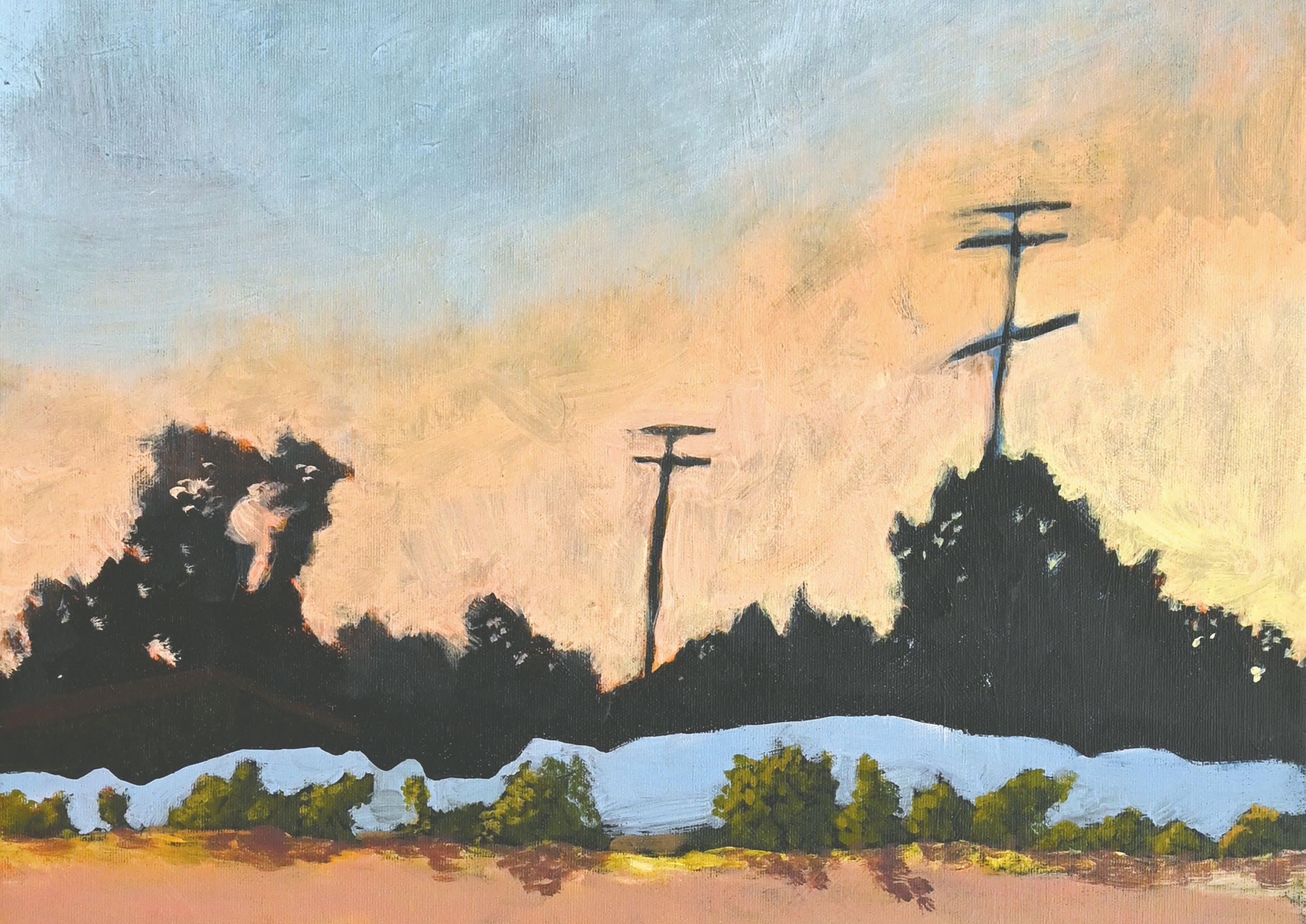
2013 Neil E Tomkins, Ginkgo Gallery, NSW
2010 SCA grad Show, Sydney Collage of Arts, NSW
Animals and Landscape, Mil’s Gallery, NSW
2008 Birds and Friends, Abattoir Gallery, NSW
2007 New and Old Work, Long Gallery, NSW
Neil Tomkins’ work is held in Private collections Nationally in NSW, VIC, QLD & TAS and Internationally in USA, MX, PT, FR, DE, MN & IN.
PROUDLY SPONSORED BY MUNDA WINES



Ancient soils, ancient culture.
